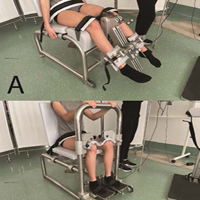 Smart Citations
Smart CitationsSee how this article has been cited at scite.ai
scite shows how a scientific paper has been cited by providing the context of the citation, a classification describing whether it supports, mentions, or contrasts the cited claim, and a label indicating in which section the citation was made.
Comparison between gymnasts and non-gymnasts in isometric strength of the lower limbs
Muscle asymmetries in gymnasts are common and can lead to injury. We aimed to determine differences in hip, knee, and ankle strength between female gymnasts and non-gymnasts, and secondly, to determine the effect of strength training intervention. Fifteen gymnasts (aged 11.19 ± 1.89 years) and 15 non-gymnasts (aged 10.92 ± 1.96 years) performed unilateral isometric maximal voluntary contractions of the hip (extensor, flexor, abductor, adductor, internal and external rotator), knee and ankle flexors and extensors on a dynamometer. Inter-limb asymmetries (ILAs) were compared across strength outcomes (MVC torque) and groups. ILAs was calculated based on the strength measurements. The gymnasts were retested after 8 weeks, during which the participants performed 5 weeks of regular training and 3 weeks of targeted strength training intervention. We found significant differences between groups in most observed hip strength parameters, but not in knee and ankle strength. The intervention did not significantly affect any parameter of ILAs. Gymnasts and non-gymnasts differ in hip strength parameters. A longer intervention program may decrease ILA parameters.
Downloads
How to Cite
PAGEPress has chosen to apply the Creative Commons Attribution NonCommercial 4.0 International License (CC BY-NC 4.0) to all manuscripts to be published.

 https://doi.org/10.4081/ejtm.2021.9663
https://doi.org/10.4081/ejtm.2021.9663





